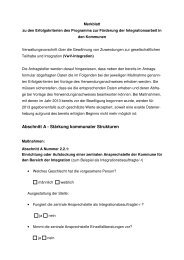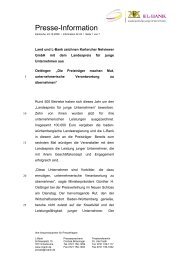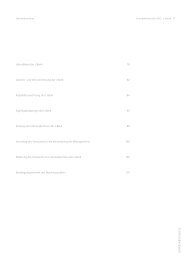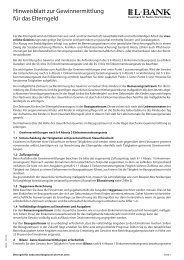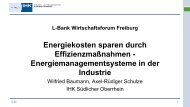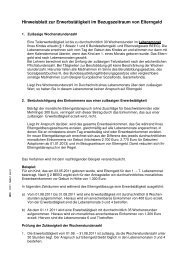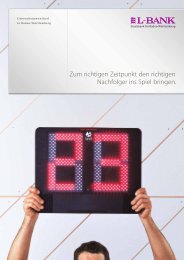Landeskreditbank Baden-Württemberg - L-Bank
Landeskreditbank Baden-Württemberg - L-Bank
Landeskreditbank Baden-Württemberg - L-Bank
Create successful ePaper yourself
Turn your PDF publications into a flip-book with our unique Google optimized e-Paper software.
which often are special purposes entities, in which a parent does not have a controlling voting interest but the<br />
parent absorbs the majority of the VIE’s expected losses or residual returns must also be consolidated. The equity<br />
method of accounting is generally required for investments where the parent company has more than 20% of the<br />
voting rights or if factors indicate that significant influence exists.<br />
Receivables (loans) and liabilities<br />
Under German GAAP, receivables (loans) and liabilities are classified according to the period after which<br />
the obligor thereof may, or may be required to, repay in full such receivables or liabilities. The Regulation on the<br />
Accounting Principles applied to Credit Institutions and Financial Services Institutions<br />
(Rechnungslegungsverordnung für Kreditinstitute und Finanzdienstleistungsinstitute), together with Section 340<br />
et seq. German Commercial Code (Handelsgesetzbuch), which mainly comprise German GAAP for credit<br />
institutions, requires that a bank classifies receivables and liabilities on its balance sheet into short-term assets<br />
and liabilities that are payable on demand (täglich fällig) and other assets and liabilities.<br />
Under U.S. GAAP, financial institutions do not present so classified balance sheets.<br />
Property and equipment<br />
Under German GAAP, property and equipment are reported at acquisition or manufacturing cost, as<br />
applicable, and reduced by scheduled depreciation in accordance with their estimated economic useful life. In<br />
practice, depreciation is carried out on the basis of the depreciation tables issued by the Federal Ministry of<br />
Finance. Based on the modified lower of cost or market principle, any expected permanent impairment of<br />
property and equipment results in additional depreciation. This additional depreciation is reversed when the<br />
reason for the impairment no longer exists.<br />
U.S. GAAP requires that property and equipment be carried at cost less scheduled depreciation in<br />
accordance with the estimated economic useful life of the asset. U.S. GAAP requires that assets be reviewed for<br />
impairment. If the sum of the expected future cash flows (undiscounted and without interest charges) is less than<br />
the carrying amount of the asset, an impairment loss is recognized. Such impairment losses shall not be reversed.<br />
Investment securities<br />
Under German GAAP, investment securities are defined in Section 7 of the Regulation on Accounting by<br />
Credit Institutions and Financial Services Institutions (Verordnung über die Rechnungslegung der Kreditinstitute<br />
und Finanzdienstleistungsinstitute); in the balance sheet they are disclosed under “Notes and other interestbearing<br />
securities” and “shares and other non interest-bearing securities.” In disclosing income and expenses, a<br />
distinction is made between securities held in trading portfolios (Handelsbestand) and those held as liquidity<br />
reserves in the liquidity portfolio (Liquiditätsreserve) (securities which are neither treated as fixed assets nor held<br />
for trading purposes). In both cases the securities are carried as current assets and are valued, for each type of<br />
security separately, at the lower of cost or market value at the balance sheet date and included in income.<br />
Under U.S. GAAP, investments in equity and debt securities are classified into the categories trading,<br />
available-for-sale or held-to-maturity (for debt securities only). Debt securities held to maturity are carried at<br />
amortized cost. Held to maturity and available for sale securities are subject to (other-than-temporary)<br />
impairment tests. Trading and available-for-sale securities are recorded at fair value and changes of trading<br />
securities in fair value are included in the income statement. Changes in the fair value of available-for-sale<br />
securities are included in other comprehensive income, a separate component of equity, unless a decline in fair<br />
value is deemed to be other-than-temporary. If the decline is other-than-temporary the loss is included in the<br />
income statement.<br />
Provision for loan losses<br />
Under German GAAP credit institutions are permitted to create loss risk provisions that, in accordance with<br />
German law, are not disclosed.<br />
82



